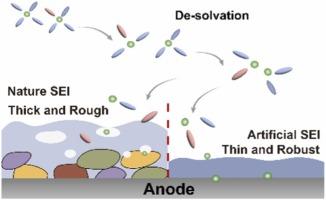高能锂电池人工SEI研究进展:机理、制造策略及结构-性能关系
IF 17.1
1区 材料科学
Q1 CHEMISTRY, PHYSICAL
引用次数: 0
摘要
锂离子电池以其优异的电化学性能引起了人们的广泛关注。然而,在苛刻的条件下,诸如枝晶生长、体积膨胀和活性物质损失等挑战(源于相间不稳定性)继续限制电池的性能和商业可行性。固体电解质间相(SEI)对电池的稳定性和寿命起着至关重要的作用。除了自然形成的SEI外,人工SEI (Art-SEI)的制备也被证明可以增强间相稳定性。本文将分析和强调SEI的演变、形成和离子传输机制,以及合理的设计策略和结构与性能之间的关系。概述了Art-SEI的结构组成、生长行为和离子迁移过程。概述了表征和计算方法的最新进展,以阐明微观结构演变,组分分布,离子传输途径和界面相容性。这些见解为设计具有定制结构和高性能lib特性的Art-SEI提供了指导方针。本文章由计算机程序翻译,如有差异,请以英文原文为准。

Recent progress of artificial SEI for high-energy lithium batteries: Mechanisms, fabrication strategies and structure-performance relationships
Lithium-ion batteries (LIBs) have attracted considerable attention owing to their excellent electrochemical properties. However, challenges such as dendrite growth, volume expansion, and active material loss, stemming from interphase instability, continue to limit battery performance and commercial viability under demanding conditions. The solid electrolyte interphase (SEI) plays a key role in controlling battery stability and lifespan. In addition to the naturally formed SEI, fabrication of artificial SEI (Art-SEI) was effective to enhance interphase stability. This review will analyze and highlight the evolution, formation, and ion transport mechanisms of SEI, along with rational design strategies and the correlation between structure and performance. The structural composition, growth behavior, and ion migration processes of Art-SEI are outlined. Recent advances in characterization and computational methods are summarized to elucidate microstructural evolution, component distribution, ion transport pathways, and interfacial compatibility. These insights provide a guideline for the design of Art-SEI with tailored structures and properties for high-performance LIBs.
求助全文
通过发布文献求助,成功后即可免费获取论文全文。
去求助
来源期刊

Nano Energy
CHEMISTRY, PHYSICAL-NANOSCIENCE & NANOTECHNOLOGY
CiteScore
30.30
自引率
7.40%
发文量
1207
审稿时长
23 days
期刊介绍:
Nano Energy is a multidisciplinary, rapid-publication forum of original peer-reviewed contributions on the science and engineering of nanomaterials and nanodevices used in all forms of energy harvesting, conversion, storage, utilization and policy. Through its mixture of articles, reviews, communications, research news, and information on key developments, Nano Energy provides a comprehensive coverage of this exciting and dynamic field which joins nanoscience and nanotechnology with energy science. The journal is relevant to all those who are interested in nanomaterials solutions to the energy problem.
Nano Energy publishes original experimental and theoretical research on all aspects of energy-related research which utilizes nanomaterials and nanotechnology. Manuscripts of four types are considered: review articles which inform readers of the latest research and advances in energy science; rapid communications which feature exciting research breakthroughs in the field; full-length articles which report comprehensive research developments; and news and opinions which comment on topical issues or express views on the developments in related fields.
 求助内容:
求助内容: 应助结果提醒方式:
应助结果提醒方式:


